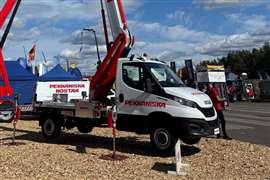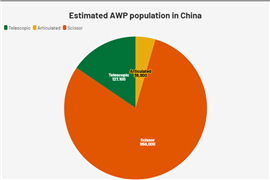3 positive messages from Herc Rentals’ Investor Days
29 November 2023
Higher interest rates come with challenges, but for US equipment rental firms, there are reasons to be optimistic, and it’s not just good news for the large national chains. Smaller regional outfits and independents can capitalize on trends that suggest opportunities lie around many corners.
 Larry Silber, president and CEO, Herc Rentals (Photo: Herc Rentals)
Larry Silber, president and CEO, Herc Rentals (Photo: Herc Rentals)
Herc Rentals is on a trajectory for growth, with big plans for expansion through acquisition and a steep increase in capital expenditures predicted over the next three years. Good news for the number-three U.S.-based rental chain, but what bits of wisdom can smaller businesses glean from Herc’s vision? Here, we give you three positives to consider.
These and other points were covered during the Q&A portion of Herc Rentals’ recently held Investor Day, where the company highlighted new three-year targets for revenue growth.
For smaller regional and independent rental companies looking into their respective crystal balls, there are reasons for optimism.
Rental penetration will only go deeper
Herc Rentals executives say all signs point to rental penetration deepening in the near- and long-term future, despite headwinds from higher interest rates.
According to the American Rental Association (ARA), rental penetration currently stands at 53.8% and is expected to take a turn upward next year and beyond, as rental gains an increasingly firm hold on the way consumers approach getting things done. It’s a well-documented trend that younger generations appreciate the ability to pay for services as they go and avoid the overhead expenses of owning assets.
But with the focus in construction on mega projects coming on line over the next few years, it’s not out of line to think the trend could swing back the other way, at least for large contractors looking at several years on a single, massive project.
Not so, says Larry Silber, president and CEO of Herc Rentals. “We’re hearing less and less that contractors want to own equipment. Once a contractor decides he’s going to go with rental, he loses that need for equipment maintenance, transportation and logistics, of buying capacity or buying at the right price. He also has the ability to off fleet when he’s not using machines.”
Silber said he doesn’t expect a long runway of projects to change that thinking, a point that’s particularly interesting considering the growing trend of specialty rentals. “Contractors want to own equipment less and less. Even on specialty gear they might have owned themselves in the past, they’re going in the direction of rental. It’s a secular trend that I don’t see shifting.”
Higher interest rates support rising rental rates
Another factor driving the trend to rent is higher interest rates, which have contractors looking at the rising cost of money to buy and own machines. Marc Humphrey, senior vice president and
chief financial officer at Herc Rentals, says in turn, this is good news for rental companies as they set rates going forward.
“When you think about the economic impact of inflation on today’s fleets, as well as what interest rates looks like, I think all of that aligns to a very attractive pricing market as we go forward,” he said.
Now might be a good time to buy or sell a business
What effect might higher interest rates have on mergers and acquisitions?
Silber said the rising cost of capital, as well as the machines themselves, could serve as motivators for rental businesses to sell.
“I think as long as interest rates remain where they are, perhaps we’ll see more of that,” he speculated, noting the Federal Reserve agreed in November to hold interest rates firm for the foreseeable future, without reduction.
The pipeline of independent rental companies available for sale is not endless, however, and a question arose over whether Herc could achieve its goals for expansion through acquisition with dwindling numbers of attractive prospects to buy.
“The ARA sent me a report that their base of ‘mom and pop’ players has grown to nearly 6,000 local rental stores,” Silber said. “That’s a pretty significant rate of growth over the last couple of years. It seems like no one ever really goes out of business at the mom and pop level. They sell their business and then work out their non-compete and come back five years later and they’re in business. Then maybe four or five years after that, we get an opportunity.”
He continued, “So while I would say there are limited amounts of larger regional players available out there, there are a significant amount of mom and pops available. Now we’re turning to specialty equipment, where there are additional opportunities. I think for the foreseeable future, and certainly the next three-year period, we’re not going to run out of opportunities to look at M&A targets.”
STAY CONNECTED



Receive the information you need when you need it through our world-leading magazines, newsletters and daily briefings.
CONNECT WITH THE TEAM












